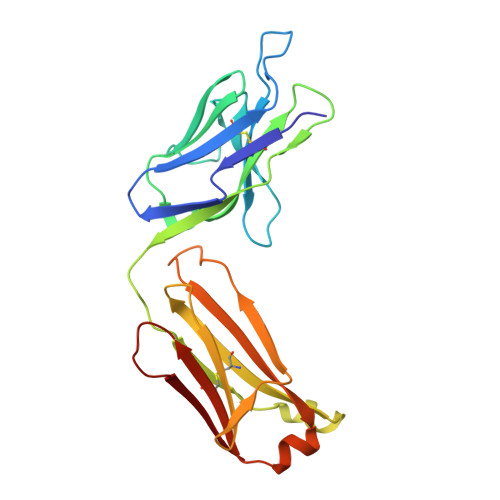Crystal structure of a TSH receptor monoclonal antibody: insight into Graves' disease pathogenesis.
Chen, C.R., Hubbard, P.A., Salazar, L.M., McLachlan, S.M., Murali, R., Rapoport, B.(2015) Mol Endocrinol 29: 99-107
- PubMed: 25419797
- DOI: https://doi.org/10.1210/me.2014-1257
- Primary Citation of Related Structures:
4QT5 - PubMed Abstract:
The TSH receptor (TSHR) A-subunit is more effective than the holoreceptor in inducing thyroid-stimulating antibodies (TSAb) that cause Graves' disease. A puzzling phenomenon is that 2 recombinant, eukaryotic forms of A-subunits (residues 22-289), termed active and inactive, are recognized mutually exclusively by pathogenic TSAb and mouse monoclonal antibody 3BD10, respectively. Understanding the structural difference between these TSHR A-subunit forms could provide insight into Graves' disease pathogenesis. The 3-dimensional structure of the active A-subunit (in complex with a human TSAb Fab, M22) is known, but the structural difference with inactive A-subunits is unknown. We solved the 3BD10 Fab 3-dimensional crystal structure. Guided by prior knowledge of a portion of its epitope, 3BD10 docked in silico with the known active TSHR-289 monomeric structure. Because both TSAb and 3BD10 recognize the active TSHR A-subunit monomer, this form of the molecule can be excluded as the basis for the active-inactive dichotomy, suggesting, instead a role for A-subunit quaternary structure. Indeed, in silico analysis revealed that M22, but not 3BD10, bound to a TSHR-289 trimer. In contrast, 3BD10, but not M22, bound to a TSHR-289 dimer. The validity of these models is supported experimentally by the temperature-dependent balance between active and inactive TSHR-289. In summary, we provide evidence for a structural basis to explain the conformational heterogeneity of TSHR A-subunits (TSHR-289). The pathophysiologic importance of these findings is that affinity maturation of pathogenic TSAb in Graves' disease is likely to involve a trimer of the shed TSHR A-subunit.
- Thyroid Autoimmune Disease Unit (C-R.C., L.M.S., S.M.M., B.R.) and Department of Biomedical Sciences (P.H., R.M.), Cedars-Sinai Research Institute and UCLA School of Medicine, Los Angeles, California 90048.
Organizational Affiliation:

















